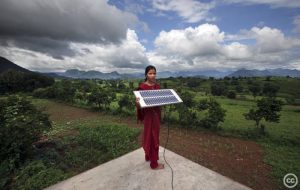Summary From Day Two: Low Carbon Options For South Asian Countries
By Navam Niles
The second day of the workshop continued on the broad theme detailing the objectives of low carbon development, including: creating awareness on local carbon development, sharing country and sectorial case studies and developing a long-term regional low-carbon development strategy. The goals emphasised the need to associate the low carbon development strategy with the broader NAPAs, NAPs, INDCs and regional efforts such as the SAARC Summit , which is to take place in November in Kathmandu. Importantly, it acknowledges the necessary contributions towards low carbon development from both developed and developing countries. The second day featured four key sessions: low carbon options in Pakistan, India, Bangladesh and South Asia.
Low Carbon Options in Pakistan
The first session featured three presentations: impediments and opportunities related to low carbon development, low carbon and disaster resilient alternatives and energy efficient brick production. Together, the presentations covered key social and technical challenges and opportunities Pakistan faces in its efforts to move towards a low carbon economy over the next few decades. While noting relatively broad support for low carbon option schemes designed to enhance food security, water security, energy security and human security, the speakers elaborated on the status and potential for relevant technologies in Pakistan. The discussions and feedback focused on the main bottlenecks towards Pakistani low carbon development involving the investment climate, regulations and the mind-set of consumers. The speakers noted that Pakistan needed a robust enabling environment and the main obstacle was political and not technical. Specific questions towards the speakers, focused on the financial viability and social acceptance of new technology, especially those living in poverty. The speakers responded by highlighting the social challenges and opportunities encountered during implementation.
Low Carbon Options in India
The second session featured four presentations: impediments and opportunities to low carbon development in India, low carbon technology in the construction and infrastructure sectors, implementation of low carbon appropriate bamboo technology, and the use of low carbon cement. These presentations touched upon the public policy and technical challenges towards low carbon technology. Moreover, the speakers briefed participants on the status and alternatives to such low carbon technologies. The speakers noted that low-carbon options were generally cheaper, healthier and less energy intensive. However, apart from technical challenges, cultural stigma towards low-carbon (and low cost) technologies and the prevalent mind-set amongst policymakers remained key obstacles to implementation. During the discussion phase, speakers were questioned on the capacities of the low carbon technologies and their viability in the long-term. In addition, questions focused on the compatibility of such systems with orthodox low carbon systems such as solar and wind power. In responses, speakers elaborated on the key technical details of their respective case studies. Policy related questions also drew attention, especially policies designed to enhance electricity access and implement smart subsidies that help the poor but reduced the incentive to waste energy.
Low Carbon Options in Bangladesh
The third session for the day involved low carbon options in Bangladesh and featured multiple presentations including: opportunities and impediments to low carbon development in Bangladesh, and consultation on low carbon options for South Asian countries and sectors. These sessions examined key public policy and technical challenges and opportunities faced by low carbon advocates. Speakers briefed participants on the viability of such systems and explained that while low carbon options are cheaper and more energy efficient than traditional energy systems, access to finance and the lack of an enabling environment remain key challenges. Since the rural poor mostly use such systems, the lack of access particularly harms the vulnerable and marginalised elements of Bangladesh. However, while elaborating the case study, the speaker spoke on the viability of their low carbon systems and the manner in which they addressed implementation gaps. In the discussion phase, participants quizzed speakers on the viability of their technology and the main financial and maintenance related challenges amongst poor communities in Bangladesh. Issues such as micro finance, after-sales services and quality control were cited as important elements for successful implementation.
Low Carbon Options in South Asia
The final session was that of low carbon options in South Asia, featuring the topic mapping low carbon opportunities for South Asia for energy and carbon security. Multiple discussants from the South Asian region gave their opinions on emerging opportunities. They argued that while the biggest challenge is generating resources that could be devoted to reducing GHGs, resources should not be considered a fixed constraint on GHG reductions. They also argued that it is important to understand low carbon development in terms of adaptation and mitigation. In this regard, public policy and public perception of such a strategy is important. Moreover, discussants agreed that it is important to engage multiple stakeholders, ensure appropriate levels of R&D, invest in vulnerable groups and work towards enhancing regional cooperation on low carbon development.
About The Author:
Navam Niles works as a Research Associate at SLYCAN, focusing on energy security and the politics concerning global environmental problems. His core research interests also include Public International Law, International Development, Foreign Policy Analysis, and International Security. In addition, he is a lecturer at the Royal Institute of Colombo, teaching subjects pertaining to Politics, International Relations and Development Studies.





